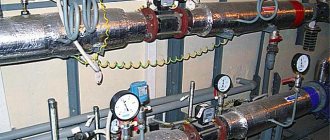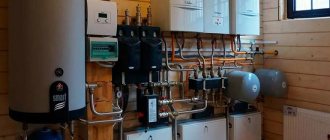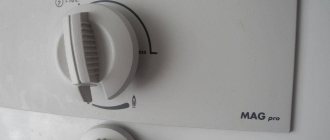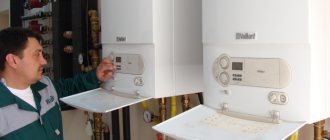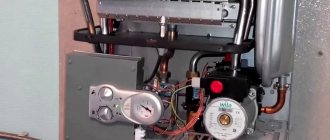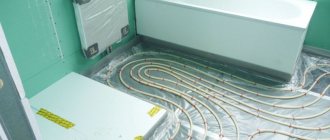Using an electric boiler in an apartment or private house is the easiest and most affordable way to provide your home with hot water supply (DHW). Storage-type water heaters do not require installation permission or a powerful power input, since they consume only 2-3 kW/h of electricity. But the latter costs a lot of money, so homeowners have a natural question - how to use a water heater to save electricity. Let's try to give a detailed answer to it.
Design features of electric water heaters
Understanding the general operating principles of boilers will help you understand how you can make them energy efficient. The following equipment is located in the housing of electric heaters:
- tank;
- heating element;
- Control block;
- thermometer;
- check and safety valves;
- protective automation.
We recommend the product Boiler Atlantic Steatite Elite VM 80 D400-2-BC 1500W 7 reviews
In stock
Volume, l: 80 | Heating element type: dry | Height, mm: 811 | Width, mm: 433 | Depth, mm: 451 | Heating element power, W: 1500 |
When the container is filled with water, the heating element is turned on, which is responsible for heating the water. The user sets a certain temperature, upon reaching which the heating process in the tank is completed. In the absence of water consumption, the device’s automation maintains the heating temperature by periodically turning on and off the heating element.
Manufacturers produce boilers with open and closed heating elements. In the first, the heating element comes into direct contact with water, in the second, this does not happen. Therefore, water heaters with a closed heating element are more reliable and durable.
The formation of corrosion in boiler tanks is prevented by a magnesium anode. This metal is gradually destroyed during the operation of the water heater, i.e. takes the “blow” upon itself, protecting the tank itself, as well as the heating element, from destruction if it is in direct contact with water.
Design and principle of operation of the equipment
To rationally reduce energy costs, it is worth understanding the design of the water heater. It is designed as a tank made of stainless steel or steel with a layer of thermal insulation. Magnesium anodes are built into the steel tank to prevent corrosion and electrochemical reactions. A tubular heater with a thermostat is built into the container. At the bottom of the tank there are pipes that supply and discharge water. The thermostat and thermometer are located on the front or bottom panel.
The device works as follows:
- Cold water is poured into the container through a hose with valves - safety and return.
- The heating element turns on automatically and heats the water.
- When the contents of the tank reach the desired temperature, the heater is turned off using a thermostat.
- In models without water intake, the heating level is maintained in auto mode - the heating element turns on and off after a certain time.
- When the hot water tap on the mixer is opened, water is drawn from the top through a special tube.
Boiler device
Important! If the magnesium anode or heating element breaks down, electricity consumption may increase.
Features of installation of water heating equipment
Proper installation is one of the factors that directly influences how much it will be possible to save energy during the operation of the boiler. When performing installation work, it is important to take into account all the manufacturer’s recommendations. Depending on the brand, they may vary slightly, but the basic rules are as follows:
- to connect to the electrical network, you must use a copper cable;
- fastening must be done on a permanent foundation, since the mass of equipment filled with water is quite large;
- it is necessary to perform grounding;
- installation must be carried out in a vertical or horizontal position in accordance with the manufacturer's instructions;
- connection to the water supply system must also be carried out strictly according to the instructions.
We recommend the product
Boiler Gorenje GBF 80/UA 11 reviews
In stock
Volume, l: 80 | Heating element type: dry | Height, mm: 829 | Width, mm: 454 | Depth, mm: 461 | Heating element power, W: 2000 |
Determining the efficiency of a new water heater
How to start using your new boiler economically and correctly? Experts focus on determining its energy efficiency when purchasing.
General rules
Before purchasing equipment, the user needs:
- compare the energy efficiency of expensive and budget models in the store to establish the return on investment of the equipment;
- clarify that the energy efficiency class includes efficiency, losses per hour during heating and maintaining temperature, circulation. Information is indicated in the manufacturer's booklet;
- take into account the displacement of the container, the operating speed of the heating element, the type of installation to clarify the total costs.
Interesting to know! On European boiler models, energy efficiency has been indicated since 2013, on American ones - since 2009.
Calculation of annual operating costs
For calculations, you will need information about the energy efficiency class, type and cost of the coolant. Further calculations are performed using the formula:
- for gas models, the number of days per year is multiplied by energy efficiency and the cost of a cubic meter of gas;
- for electric boilers, the number of days per year is multiplied by energy efficiency and the cost of kW/hour.
Interesting to know! The DOE test for water heaters takes into account cold (15 degrees) and hot (60 degrees) temperatures and determines the unit's performance for a family of 3 as 240 liters per day.
Heating element power as a saving factor
The greater the power of the heating element, the faster the water will heat up. Keep in mind that in houses with a single-phase wiring diagram, from 7 to 10 kW of power are allocated. A high-performance water heater will lead to increased load on the network, huge energy costs and tripping of circuit breakers.
If you turn it off and on according to a schedule?
When using a boiler, savings are possible if the equipment only heats water when it is needed. For example, if the family is at home only in the morning and evening, hot water is not needed throughout the day. Accordingly, a constantly running boiler that consumes a significant amount of electricity leads to completely wasteful expenditure of money. It is optimal to turn off the electric water heater in the morning and turn it on in the evening.
This practice is relevant for owners of boilers with a volume of 50-80 liters. If more powerful equipment is used, it makes no sense to turn it off, since significant time is spent on heating, and therefore electricity. Experts recommend leaving such water heaters in standby mode while you are away from home. If you do this, increasing the temperature parameter will allow you to use hot water within an hour.
An effective solution to the problem of how to save electricity if you have a boiler is to purchase such a simple and affordable device as a timer. This equipment is relevant for the owner of an electric water heater, regardless of the volume of the tank. Using a timer, you can easily set the periods of operation and shutdown of the boiler. In some expensive models of water heating equipment, the timer programming function is built-in.
Methods to reduce electricity costs
To do this, you must adhere to the following tips:
- Choose the optimal location for installing the boiler. After all, if there is too much piping going to the sink or bathtub, the heat will naturally dissipate, forcing you to spend more kilowatts.
- Select the correct mode of operation of the device. To save money, you need to correctly configure the active and inactive periods of operation of the device, namely the heating element, you can save a small amount per kilowatt.
- Carry out preventative cleaning of the heating element (heating element). By descaling it, you can increase the efficiency of the element, namely, receive the same amount of heat with less energy consumption.
By following all these points, you can save a small amount of electricity, which will have a positive impact on your budget.
See also -
How to clean a boiler yourself
How to find out if there is water in the boiler?
This will ensure that the water heater is filled with water. During the process of filling the storage water heater with water, air will come out of the open mixer, hissing and spitting. Don't be alarmed, wait until water flows out of the faucet in a steady stream. After that, wait another half a minute and close it.
Interesting materials:
How can I run the installed program? How to install Who's Calling on iPhone? How to set a ringtone for a group of contacts on an iPhone? How to install two Vibers on a computer? How to install Viber on a laptop? How to set a ringtone for a contact on a Samsung a51? How to set the Russian language on a smart watch? How to install Viber on a smartphone? How to find hidden installed programs on your computer? How to format a USB flash drive with Windows installed?
Shutting down for the night
It seems very logical to many to turn off the boiler at night - after all, at this time people usually sleep, and there is no need for hot water. This means that electricity is wasted on heating. On the one hand, such reasoning does seem sound. On the other hand, it is necessary to take into account that periodic heating requires much less electricity than bringing a whole tank of cold water to the desired temperature.
Therefore, you can, of course, practice complete shutdown, but the savings from this will be so-so, frankly speaking. We suggest considering a slightly different option. Almost any water heater has several operating modes, that is, you can set a certain temperature level. In this case, you should focus not only on making it comfortable to wash, but also on the issue of human health.
The fact is that various bacteria live in water, which are not always useful. Some of them can cause serious illness. Moreover, the activity and reproduction of these tiny creatures depends on the environmental conditions in which they live. In particular, on temperature:
- from 30 to 50 degrees - bacteria actively live and multiply,
- from 50 to 80 degrees - they do not die, but sleep peacefully, without reproducing,
- from 80 to 100 degrees - they die.
As you can see, operating the boiler at the lowest temperature conditions will cause active proliferation of bacteria contained in the water, which entails undoubted harm to health. And the maximum mode, of course, is disinfectant, but requires large energy costs.
Therefore, the following is considered the best option. Everyday operation occurs at 50–80 degrees. At night, you can switch the boiler to a low temperature level - this way, it will not waste a lot of energy on heating, and at the same time, in the morning you will not have to spend a lot of time (and, again, electricity) waiting for it to heat up to the desired level.
And in order to destroy bacteria that have multiplied overnight, disinfect once a week. Set the water heater to maximum heating mode and let it sit for a couple of hours. During this time, the tank will be cleared of all harmful substances, and you will be able to continue using the equipment with peace of mind.
Which boiler to choose?
Many of those who decide to purchase this device often ask the question: “Which boiler is considered economical?”
On the market you can find more than 40 names of manufacturers of water heating devices. Which one is better is actually difficult to determine, since they all meet certain standards and fit one criterion.
How to save energy
There are several ways to really reduce the cost of preparing hot water:
- Adjust the temperature on the boiler in such a way as to eliminate unnecessary electricity consumption, but without reducing the comfort for the residents of the house.
- The simplest method, accessible to everyone, is to not heat water when it is not needed.
- To save energy, you can use additional heat sources obtained at more favorable prices.
- Clean the internal elements of the unit from scale in a timely manner and abandon schemes with hot water recirculation.
The maximum heating temperature in most household appliances is 75 °C. Considering that in winter the water supply is often cooled to 8-10 ° C, an 80-liter electric heater needs up to 3 hours to reach this maximum. All this time, the heating element consumes full power (minimum 2 kW). Why not choose a more economical mode, setting the temperature to 50-55 ° C and distribute consumption in such a way that the capacity does not cover all needs?
The unit with a capacity of 50 liters can be turned off when it is not necessary to provide the house with DHW. From zero to maximum it will heat up in 1-1.5 hours
Note. Experience shows that families often do not use all the heated water. That is, after taking hygiene procedures and cooking, the temperature in the heater tank remains quite high, after which the water cools down naturally. Such use cannot be called economical.
Turning on the heater according to schedule
To save money, many families who use water in the morning for washing and in the evening for other procedures and cooking use a simple method: they turn off the unit before leaving for work and turn it on when they return home. This strategy justifies itself when the tank capacity does not exceed 50 liters - the device heats up within 1-1.5 hours.
It makes no sense to turn off 80 and 100 liter water heaters for the whole day. Firstly, after cooling, they take a long time to heat up, and secondly, they consume more energy than was saved. Hence the conclusion: it is better to set a large boiler to the minimum temperature and leave it in standby mode. When an increase in water consumption is expected, turn the regulator to maximum and in about an hour you will receive the required amount of hot water.
This is what a simple mechanical timer looks like - a socket. Price – no more than 10 USD. e.
Advice. There is an option suitable for units of any capacity. Buy a simple timer that will turn on the heating twice a day at a given time. By the way, more expensive water heaters already have a programming function for working according to a schedule.
Preheating
As mentioned above, in winter, water in centralized networks is often cooled to 10, or even 6 °C. It is clear that much more electricity must be spent to heat it. To reduce consumption, you can preheat water using other sources whose heat is cheaper. Here are some options:
A unit that heats water from two sources - a heating element and a copper coil
- Initially, purchase a boiler designed to connect to two energy sources - electricity and hot water from another source, for example, a wood or gas boiler. Such a device, shown in the photo, is equipped with a spiral water heat exchanger.
- Preheat 50-100 liters of water in an iron tank to room temperature, placing such a storage tank in the hottest room - the boiler room of a private house. In 8-10 hours, while you and your household are at work, the container will naturally warm up by 10 °C.
- Finally, use solar collectors - both factory-made and home-made. The method works well in the summer; if desired, you can place an additional tank outside, as described in the following video:
Reference. Home craftsmen from the southern regions have long adapted to making solar collectors from black polyethylene pipes placed in the yard or on the roof of the house. Thanks to this, the water heater actually does not work and does not “wind up” the electric meter.
Homemade solar collector from black polyethylene pipes
Savings from cleaning the unit
Over time, lime deposits appear on the inner surface of the tank and the heating element tubes. The harder the water in the region, the faster they grow. If the coating does not cause any noticeable harm to the material of the container, then the thickening of the tubular walls of the heating element worsens the heat transfer - the water warms up more slowly with a constant power consumption.
At some point, part of the generated heat does not have time to be transferred to the liquid and additionally heats the coil of the element itself, causing the heating element to fail. This is why timely cleaning of your water heater is beneficial in every way.
Note. The operating instructions for boilers of popular brands (Ariston, Thermex, Electrolux) do not indicate the frequency of cleaning. But there is a requirement to check the condition of the safety valve annually and once every 2 years the magnesium anode.
The hot water recirculation scheme also does not contribute to savings. Its implementation increases the convenience of using the boiler, but causes an increase in the electricity consumption spent by the heater to maintain the temperature in the circulation ring. It is not customary to connect such systems to electrical appliances; for this purpose, there are indirect heating boilers that use cheaper heat.
Boiler installation tips
Its entire subsequent operation depends on how the water heater is installed and connected, so it’s worth starting with installation. It makes sense to entrust the procedure to a specialist; he will do everything as required by the instructions included with the product. However, this information may be useful to you too.
Advice. Many stores offer free installation when purchasing boilers from some manufacturers as a promotion. You can also use this service, thereby saving your time and money.
To install a boiler in an apartment or private house, you must first hang it from the wall at a convenient height. Then, having shut off the water supply, connection to the water supply networks is carried out in accordance with the diagram:
In this case, the following rules must be observed:
- the pipes are connected to the boiler pipes using American connections;
- the drainage tap is placed on the tee and nothing else;
- a transparent tube going into the sewer is put on and fixed onto the relief valve's discharge fitting;
- when the pressure in the cold water supply network exceeds the value indicated on the safety valve body, a reducing pressure regulator should be installed at the inlet;
- shut-off valves must be closed.
When the installation is completed, you should open the water supply, and then alternately the shut-off valve at the inlet and outlet of the boiler. Then open the nearest hot tap on the mixer until water flows out of it. Now that the tank is full, the water heater can be turned on and operated. As for electric flow heaters, connecting them to the water supply is not a problem. How this is done is shown in the diagram:
It is much more important to safely connect the instantaneous water heater to the electrical network, because it has a large power consumption. Here the recommendations are clear: you need to lay a separate wiring line to the device from the metering device itself, installing automatic switches of the appropriate ratings on it.
Important. When installing any electric heater, be sure to connect it to a grounding line; this is done in accordance with electrical safety rules.
Disconnection during absence
There are situations when the water heater still needs to be disconnected from the power supply. This happens in cases where you are going to take a break from using it for a long time - for example, you are going on vacation, or the device is located in the country, where you only visit in the summer. It is clear that in such a situation, heating water is a waste of money. Therefore, you can and should turn off the water heater.
But it is important to do this correctly so that there are no problems during operation in the future. More specifically, the question concerns the need to drain water from a disconnected device. In this case, it is imperative to check the information specified in the accompanying documentation.
For example, many water heaters are contraindicated to operate with a dry heating element for a long time. If you leave them without water, then subsequently the tubular heating element simply will not work. Accordingly, it is unacceptable to drain water from such models.
But there is also equipment that can withstand drought quite well. In addition, there is another point that needs to be taken into account. If the water heater is in subzero temperatures during periods of inactivity, then if there is water in the tank, deformation of the housing may occur and, as a result, a violation of its tightness.
The conclusion is as follows. If the equipment can be stored with a dry heating element, then the water must be drained. If you can’t, then vice versa. But in the latter option, the equipment must be kept strictly warm. Do not neglect these nuances, then your water heater will give you comfort even after your long absence. Good luck!
Saving rules when using a boiler
To reduce your water heater's electricity consumption, consider the following rules:
- Initially, choose the best place to install the tank - the pipeline should not be very long. Water, passing through a long channel, quickly cools, which means that kilowatts are again needed for heating.
- Set the operating mode - there should be a period of downtime and operation.
- Carry out preventive maintenance related to the operation of the heating component. The heating element should be regularly descaled; this is the only way to increase the thermal power; thanks to periodic cleaning, it is possible to optimize the efficiency of the installation.
Choosing the right place to install the boiler
When you open a hot water tap, you will most often see slightly warm water flowing out. Why is that? You ask, since the liquid inside the heat exchanger is hot and there is no doubt about it, however, boiling water must reach the tap, having previously displaced the cold liquid located in the pipe. In a pipe 1 meter long and half an inch in diameter, due to the temperature loss, it will be necessary to cover the loss of 200 milliliters of liquid.
Once the valve on the tap is closed, you lose the same volume of warm liquid, because the “unused” liquid will remain in the pipes until the next opening of the valve. We can conclude that every time you use a tap, your boiler consumes at least 400 milliliters for each linear meter of pipe.
This expense can be optimized by reducing the length of the pipeline. Simply put, you need to install the water heater so that it is located in the middle of the kitchen and bath, but it is worth noting that it is better to make the kitchen branch shorter than the one that goes to the bathroom. After all, you open the kitchen tap much more often than in the bathroom.
However, the “suitable place” that will significantly reduce costs is not always ideal from an aesthetic point of view, much less ease of use. After all, think for yourself, not everyone can tolerate an eyesore with a water heater located, for example, in the hallway. And not every owner of a water heater will risk installing it in an inconvenient place.
If you have not been able to find the best point for installing the boiler, or you do not want to place it in an inconvenient place, you can simply insulate the hot water pipe. Install a polypropylene cover over the fittings or brackets holding the pipes, as well as the pipes and fittings. Once you secure it with tape or glue, you can start using your energy efficient boiler, thereby reducing your bill costs.
Basic rules for boiler operation
Ease of installation and operation, no special permits, and the ability to maintain high water temperatures for a long time are the main advantages of the boiler. After purchasing the device, you should definitely read the instructions - following the operating rules contributes to the efficient use of the water heater with minimal energy consumption.
The basic rules for operating the device come down to simple steps, the main thing of which is to make sure that the installation is correct and that there is grounding, if this requirement is specified in the instructions. A year after installation, it is recommended to conduct a preventive inspection.
If you use the tank frequently, it is not recommended to disconnect it from the network - frequent switching on and off leads to breakdowns of the automation. All hot water valves should be closed before turning on.
Under no circumstances should the water heating device be disconnected from the network during operation.
How to clean the heating element with your own hands
The dirtier the heating element in the boiler, the less its functionality. Electricity absorbs the layer of scale, removing it, the device is updated and works with renewed vigor. To clean the heating element with your own hands, follow the step-by-step instructions:
- Drain the system.
- Disconnect from the power supply and dismantle the heating element.
- Add 1.5 liters of water to 15 grams of citric acid and mix.
- Place the heating element in the prepared solution.
- When the heating element is clean, put it back into the housing.
- All that remains is to connect the product to the water supply and provide power.



